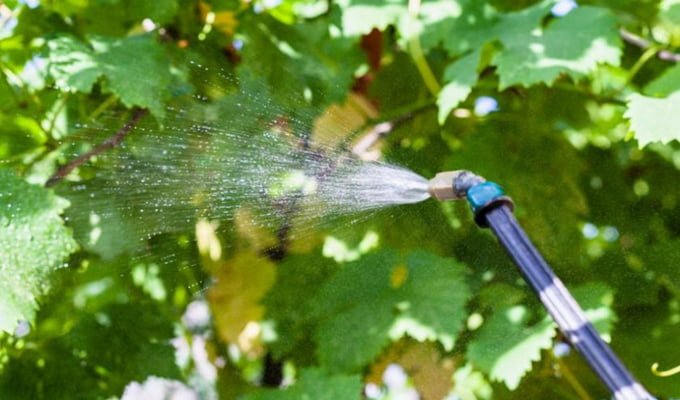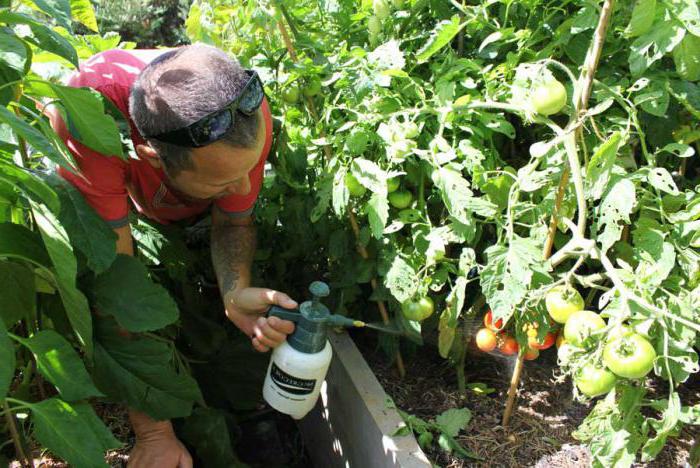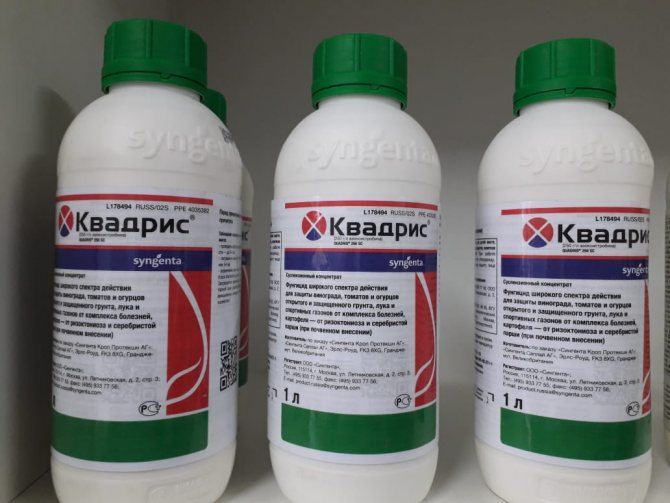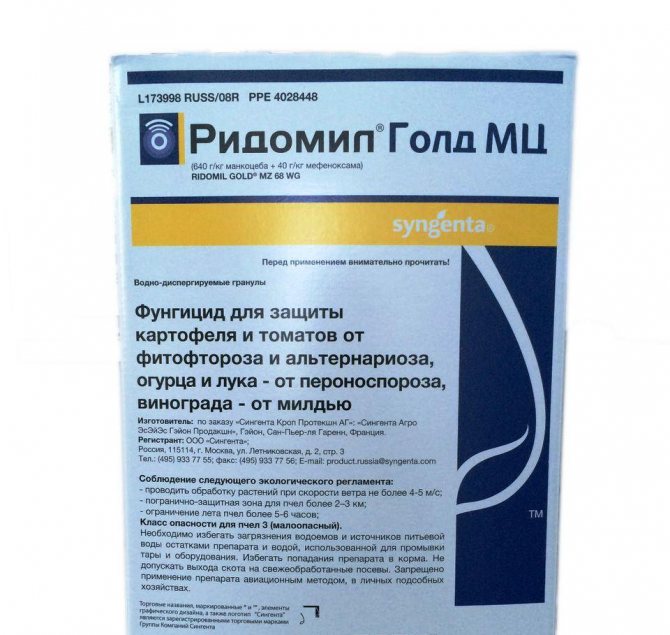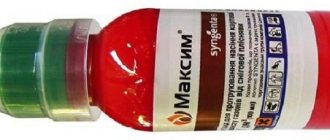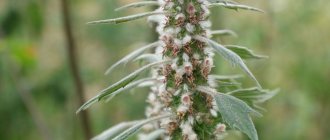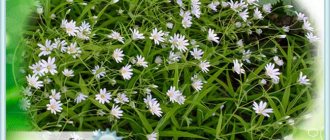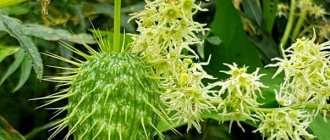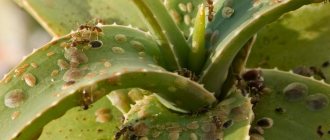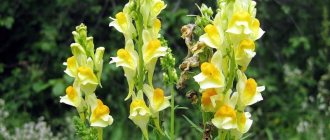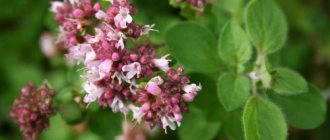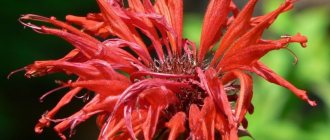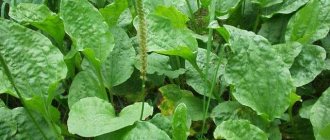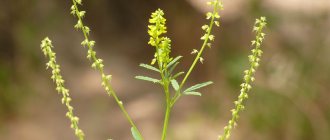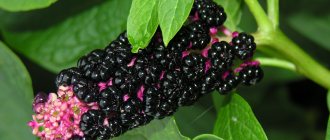Ridomil is a powerful fungicide against fungal diseases of horticultural crops that cause the greatest plant depletion and yield loss. Produced by Syngenta Crop Protection (Switzerland). The active ingredients are mancozeb from the dithiocarbamate class (640 g / kg dry matter) and phenylamide mefenoxam (40 g / kg dry matter), see fig .:

The chemical composition of the fungicide Ridomil
Advantages and disadvantages
The advantages of the drug Ridomil are as follows:
- Gives a quick healing effect, incl. from neglected diseases.
- The drug Ridomil allows you to completely destroy pathogenic fungi in plants and thereby quickly, without further relapses, eliminate the focus of their infection in the area, both old and newly emerged.
- Practically does not cause resistance (resistance to the drug) in the objects of elimination.
- Gives a healing effect in parts of plants that have not been treated with the drug.
- The preparation of the working solution (see below) does not require a particularly precise dosage.
- The effectiveness of Ridomil does not depend on the cultivation conditions of the treated plants: the use of the drug is carried out according to standard regulations and schemes (also see below).
- Storage of Ridomil, in addition to the usual precautions (under constipation, inaccessible to children and animals in a room separate from the food storage), does not require additional safety measures: the drug is not flammable, not volatile, not explosive. Storage temperature range from –10% to +35 degrees Celsius.
- The effectiveness of the drug in an unopened package does not fall throughout the entire shelf life. Almost branded Ridomil in its original packaging, after 5 years of storage in an unheated dacha, acts like a fresh one.
However, the fungicide Ridomil is not devoid of serious drawbacks:
- The drug is toxic: hazard class 2 for humans (hazardous substance); for bees - 3rd (summer limit 24 hours, apiary protection zone 3 km).
- The range of action of Ridomil is very limited; however, the diseases against which it is effective (see below) cause the greatest depletion of plants and loss of yield.
- The price of Ridomil and the consumption of the drug per unit of the treated area are quite high.
- Ridomil is not stored in an unopened container: an opened package should be used immediately and completely.
- Ridomil, along with pathogens, also destroys beneficial soil fungi, so its regular use and / or overdose degrades the quality of the soil. Accelerated reclamation of the land poisoned by Ridomil with improvised means is impossible.
- The introduction of compost, humus and other household biological agents into the soil to increase its fertility in the areas where Ridomil is used is useless.
- Fungicide Ridomil is capable of accumulating in fruits and soil and giving long-term negative effects, similar to other carbamate-based products.
- Ridomil, contrary to advertising claims, is weakly phytotoxic (slightly inhibits the growth and development of plants). This is a common property of many pesticides, but in the event of an overdose or violation of the treatment schedule (tightening of the schedule for spraying), the phytotoxicity of Ridomil increases sharply.
Note: the last point among amateur growers who have personal experience with Ridomil can cause at first glance reasonable objections. But - see further in the special section.
Active ingredients in the composition of Ridomil
The drug is intended to prevent diseases caused by a whole list of fungi. The active ingredients are mefenoxam (40 g / kg). And also mancoceba (640 g / kg).


The drug will help prevent diseases
Mefenoxam is a component of Ridomil Gold, the action of which is focused on working inside plants. It protects, along with treated and untreated areas of plants, tubers. Effective in the destruction of omycete fungi (powdery mildew). Penetrates the plant in 30 minutes, resistant to washing off.
The duration of the protective properties is 14 days. The plant is protected even in case of damp weather or high risk of disease. It breaks down quickly when it gets into the soil.
Mancozeb is a contact fungicide that externally protects plants and enhances the effect of mefenoxam, increasing their resistance to pathogenic microflora. It adheres well to the leaves and stems of grapes, additionally protects against diseases such as black rot, phomopsis, rubella.
Indications for use
Since Ridomil is quite highly toxic, and due to the above features of the drug, the use of the fungicide Ridomil and its modifications (see below) is justified, firstly, at a weekend cottage, which is an essential food or commercial aid for the owner's family. Second, in the event of a sudden massive outbreak of a drug-treatable disease.
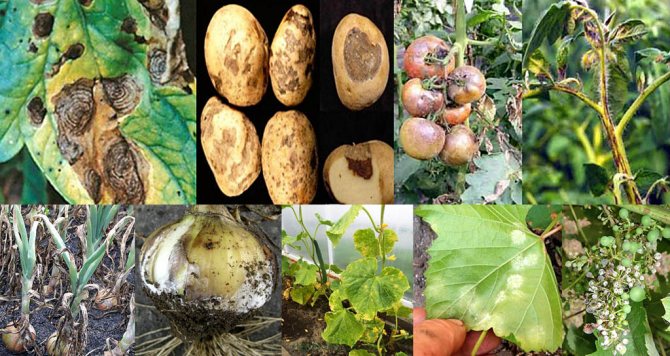

External signs of fungal diseases of plants, from which the fungicide Ridomil is effective
The drug Ridomil is most effective against such devastating diseases of the most important and important food crops as (see fig.):
- alternaria and, to a lesser extent, fusarium of potatoes;
- alternaria and, slightly weaker, late blight of tomatoes;
- peronosporosis of cucumbers and onions (for onions on a feather and other green crops, treatment with Ridomil is unacceptable!);
- mildew (downy mildew) of grapes.
The use of Ridomil on nightshades is especially effective. Even on a new, heavily infected with a pathogenic fungus, yield losses, compared with a planting sterile for this pathogen, do not exceed 5-7%, which is no more than fluctuations in yield from weather and uneven soil quality. Improper use of the drug can cause greater damage. How Ridomil works on tomatoes, see the video below:
Video: Ridomil and tomatoes
With regard to the use of Ridomil in the vineyard, then, firstly, oidium is the same scourge of grapes. The symptoms of both diseases are similar, but Ridomil for powdery mildew is ineffective. Secondly, growing grapes in a weekend dacha is of little use - they will wrap it up, it is very tempting and affordable. And it is possible to cope with mildew in the initial stages of a lesion in an area under supervision with less dangerous means. Thirdly, there is no panacea for grape diseases and is not expected; you need to keep your vineyard healthy using complex remedies, and to prevent / treat a specific disease, alternate drugs on a different chemical basis, see, for example. track. videos:
Video: the use of Ridomil for grapes
Video: overview of fungicides for grapes
The reason for the effectiveness of dithiocarbamates as fungicides, firstly, is that each such complex is a pair of carbamate "mites" that "grabbed" the ions of various metals, which makes it difficult for pathogens to develop resistance to the agent. And the high content of active sulfur further increases the fungicidal activity. Sulfur is generally a powerful remedy against fungi; let's remember about colloidal (finely dispersed) sulfur.
In general, Ridomil also acts in a comprehensive manner. Mancozeb is a water-insoluble contact fungicide; it forms a dense, resistant film on the surface of plants treated with the preparation.Mefenoxam, on the contrary, is easily soluble and quickly, in 2-3 hours, completely diffuses (seeps) into plant tissues. The translaminar activity of mefenoxam is high both in the acropetal (from bottom to top, from the roots to the vegetative and generative organs) and in the reverse basipetal direction. As a result, mefenoxam permeates the entire plant, including young shoots, leaves and buds. This component of the drug destroys young, not ready for sporulation, mycelial strands (hyphae) of fungi located deep in plant tissues and inaccessible to other means. As a result, the plant is completely healed, and the persistent film of mancozeb on the leaves and stem prevents re-infection. Since the life cycle of pathogenic fungi is several times shorter than the growing season of plants, the use of Ridomil makes it possible to completely eliminate the focus of fungal disease on the site within one season.
Note: the selective action of Ridomil is not due to its focus on the physiological mechanism of the objects of elimination, but to the peculiarities of their development in the host plant. Therefore, Ridomil is also killer for beneficial fungi-antagonists of pathogens.
Appointment
Horus: fungicide, instructions for use for grapes
It is effective to use the drug Ridomil Gold for the prevention of fungal diseases of various crops, including grape mildew. The agent is especially effective in the treatment and prevention of peronospore fungi, for the elimination of powdery mildew species, the effectiveness is much lower.
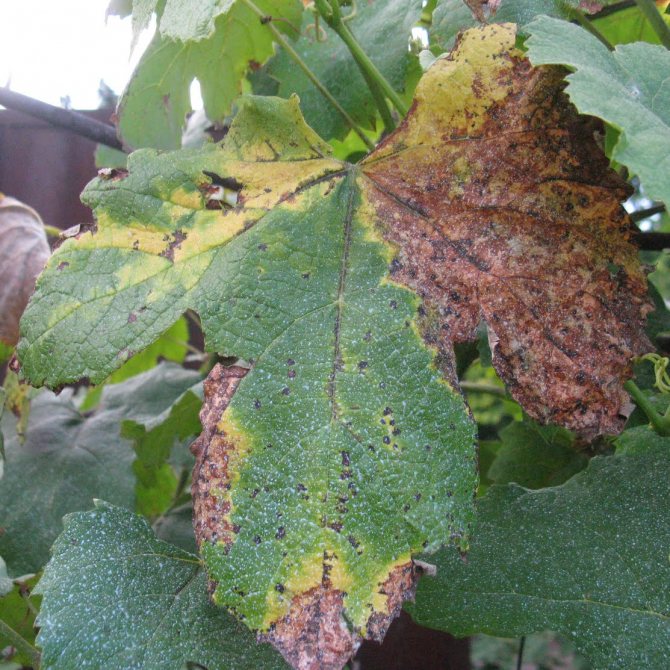

Milde of grapes
Release forms and analogues
Fungicide Ridomil for small areas is available in granular forms Ridomil Gold and Ridomil Gold MC. Granulation is carried out according to the PEPIT technology patented by the manufacturer, according to which dense, dust-free beige grains are formed, completely dispersing in water in less than 1 minute. As a result, the preparation of a working solution of the drug requires elementary precautions: latex gloves on the hands, glasses on the face and a gauze bandage. But work with Ridomil on the site must be carried out in full compliance with the safety rules for substances of the 2nd hazard class, see below!
Compositionally analogous to Ridomil are fungicides Tyler, Tragon, Fungicide Gold-M (what kind of marketer came up with the name?), Healer and Juncker, produced in neighboring countries. But (remember, it will still come in handy, see below), the only registrant of Ridomil in the Russian Federation is Syngenta Crop Protection and they are not yet selling a license for PEPIT. Therefore, firstly, it is necessary to work with analogues of Ridomil at all stages of use as with substances of the 2nd hazard class, no matter what is written on the packaging. Secondly, Syngenta does not in any way guarantee the purity of analog components and the quality of their manufacture.
About fakes


Syngenta Crop Protection brand name
In view of the effectiveness of Ridomil in especially severe emergencies, there are a lot of no analogues on the market, but outright falsifications of the drug. There is no need to be guided by the original in terms of price: roguish artisanal manufacturers know consumer psychology very well and often pay a price higher than the real one for the "palette". It is also impossible to open unpaid packaging and examine whether the granules are loose or dusty at the point of sale. The first way to distinguish an original from a fake is by the manufacturer's trademark. Its exact appearance, colors and proportions are shown in the figure .. Let us recall that the only registrant of Ridomil in the Russian Federation is Syngenta Crop Protection, and they have not yet sold licenses for this drug. Outright theft of a corporate logo in Russia is punishable quite severely, and Switzerland is not a state with which anyone in their right mind would take liberties. Therefore, counterfeiters either tear apart the Syngenta logo, or distort it, or do not put it at all.So, if this sign is not on Ridomil's bag, or it is somehow different, do not take it.
The second, effective for the products of a number of completely reckless foreign manufacturers, is in packaging. Ridomil for large areas is produced by Syngenta only in boxes of 1 and 5 kg, and Ridomil Gold and Ridomil Gold MC in vacuumed sachets of 25 and 50 g. The original preparation is weighed exactly; packaging (sachet) weighs approx. 1.2 and 1.6 g respectively Place the bag on a precision balance (electronic ex.); if the weight "disperses" - do not take this / here. And if the weight is indicated on the package, say, 20 g, then this is definitely either "singed", or not the best of the analogues, see the video:
Video: fake Ridomil
Myths about Ridomil
A good portion of the materials on Ridomil on the Runet were written by the authors, some of whom give the impression that, forgive me, they do not understand which end of the shovel should be dug. They rewrite firm manuals in good faith, but, firstly, without delving into the meaning. Secondly, only the main part, and notes, explanations and additional materials with the results of independent research for the sake of "accessibility" of the text are simply ignored. As a result, there are a number of incorrect statements about Ridomil:
- Ridomil is a prophylactic drug. In fact, he is a typical ambulance, powerful but dangerous. Preventive spraying with Ridomil is carried out only on infected areas, where acc. the incidence of plants (see above) repeats from year to year. After the site is rehabilitated, the treatment with Ridomil is stopped, especially since carbamates require alternation with pesticides on a different chemical basis. If the focus of the disease has arisen suddenly in a healthy area, the frequency of treatments is reduced by 1 (see below).
- It is easy to process plants with Ridomil. On the contrary, see below. The simplicity of the application regulations does not at all mean the technical simplicity of the work.
- Ridomil helps with almost all fungal rot. No more other less dangerous dithiocarbamates. Ridomil is a specialized drug. "Universal", but even more dangerous means of ambulance in severe cases of damage to vegetative parts of plants by fungi pathogens - Fundazol.
- Ridomil can be used for fruit rot. No and no again. Mefenoxam easily penetrates into fruits and accumulates in them. A means to protect the crop from scab, moniliosis, etc. - Horus.
- Ridomil can be used on flowers and indoor plants. Absolutely not. After approx. After 10 days, the mancozeb film on the plants begins to disintegrate and the substance of the 2nd hazard class appears in the air.
Is Ridomil a stimulant?
The property of Ridomil supposedly to stimulate plant growth should be said especially, because it is declared in some manuals of rather serious suppliers. At first glance, the reasoning is convincing: here, look, they sprinkled grapes with Ridomil from mildew, and the bush grows better than a healthy one in the next row.
This is an impure experience. The visible powdery mildew on grapes is a mature mycelium with sporangia of the causative agent of the disease - the imperfect fungus Plasmopara viticola (Uncinula necator (= Oidium tuckeri) on Wikipedia - incorrect). A "healthy" bush nearby is also affected; mildew is no less infectious to grapes than the plague is to humans. It has already been penetrated by the young mycelial strands of the pathogen, and therefore it grows worse than sterile. Healed better than a patient in the latent phase of the disease, but still worse than a really healthy one.
Note: absolutely all pesticides inhibit plants to one degree or another. It's just that without them, the lag in development and crop losses will be even greater.
What diseases of grapes is used for
The chemical "Ridomil Gold" is used for mildew and powdery mildew, and it is also used to treat fungal diseases in grapes.
Mildew
The first sign of mildew in grapes is the appearance of light spots on the leaves. Then a white bloom appears on the bottom of the sheet.Inflorescences and young ovaries dry up and fall off.
For the treatment of grapes, Ridomil Gold is used. It is used as a prophylactic agent. The vine is sprayed in dry, calm weather. In case of severe damage to the vines, the bushes are treated with curative fungicides, and after 10 days, Ridomil Gold is used.
Oidium
Oidium or powdery mildew often infects vines. In the spring, you can notice growths on the grapes, which lag behind in growth, unlike other parts of the bush. Twisted leaves with a white bloom appear on them.
See also
Description and characteristics of Ruslan grapes, its advantages and disadvantagesRead
The bushes are treated with Ridomil Gold from powdery mildew. Fungicide is aimed at fighting fungi. The vine is sprayed in dry weather. After 14 days, spraying is repeated. If necessary, the drug is combined with other chemicals.
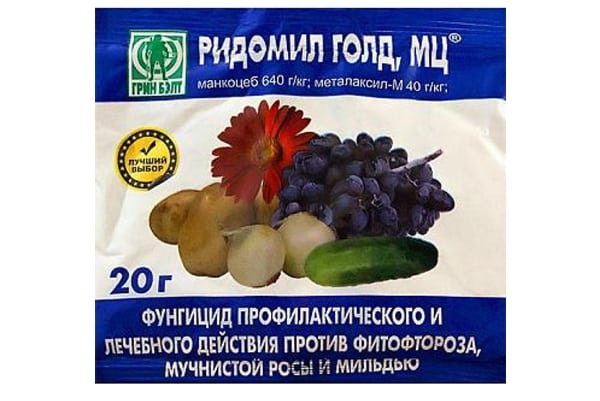

Precautions
Mefenoxam penetrates into the human body as easily as into any other humid environment. Therefore, you need to work with Ridomil in a full set of PPE, see Fig., And in a respirator with gas cartridges. Since such a kit is by no means cheap, in the case when you need to cope with a sudden outbreak of the disease, it is better to call a specialist for treatment.
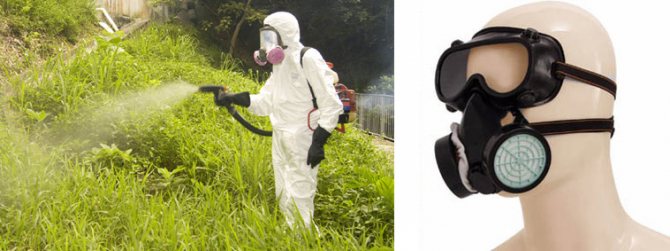

Ridomil suppresses healthy plants more than sick ones, and also destroys useful fungi. Therefore, the precautions for plants when processing this drug are as follows:
- Continuous plantings can be sprayed with winds up to 4-5 m / s (leaves on trees begin to flutter a little; thin branches sometimes sway);
- A shingle in a small area is treated only in calmness, preventing the drug from getting into neighboring healthy plantings;
- The treatment is carried out from a sprayer giving a misty stream until a continuous film of the solution forms on the plants. The dripping of solution drops onto the soil is unacceptable! Therefore, the following rates of consumption of the working solution are relative - the processing process must be carefully monitored visually.
In any case, the security belts of the work area with Ridomil are as follows:
- non-residential buildings - 15 m;
- helpers and other healthy people - 15 m to the wind from the jet;
- residential buildings, children's facilities, reservoirs, water supply sources - 50 m;
- for children, allergy sufferers, cancer patients or those who have been ill, pregnant women, nursing mothers - 50 m;
- apiary - 3 km (limitation of summer bees from 24 hours).
Note: there are no obvious primary symptoms of Ridomil poisoning. In case of any deterioration in well-being, you should immediately stop working and consult a toxicologist.
Compatibility
Ridomil in tank solution is compatible with most pesticides. But due to the complex composition of the drug, the manufacturer does not provide a list of agents compatible with it, especially since the range of pesticides on sale is changing. For the same reason (complex composition), checking the compatibility of Ridomil with improvised means at home does not always give an unambiguous result. If the compatibility is precisely established (for example, by consulting on the company's website or with a specialist), then the dissolution of substances in the tank (see below) is made necessarily in the next. order: water-soluble agents (VRK, VRP, VRG)> SP (wettable powder)> RIDOMIL GOLD MC, VDG> KS (concentrated suspension; sometimes referred to as SC on foreign products)> EC.
Note: VRK - water-soluble concentrate; VRP - water-soluble powder; VRG - water-soluble granules; VDG - water-dispersed granules; EC is a concentrated emulsion.
Features of the drug
Ridomil Gold is an effective drug that belongs to the group of fungicides characterized by systemic contact action. The product is presented on the market as powder or water-dispersible granules in various packaging forms.
The chemical composition is as follows:
- Mancozeb (64%) penetrates deep into the plant and acts systemically on infections, i.e. protects all parts of the culture: from the roots to the very tips of the leaves;
- Metalaxin (8%) remains on the leaf surface, adding protection and preventing re-attack by the fungus.
Important! Fungicide Ridomil Gold belongs to the substances of the second group of danger for humans and the third for bees. It is important to ensure that the product does not get into water bodies, as the substance is detrimental to fish.
Preparation of working solution
To work with Ridomil, a sprayer with a built-in or separate submersible electric (mechanical) agitator is required. You cannot prepare the mother liquor, pour it from the tank and shake it with your hands! The working solution of Ridomil (possibly in a mixture, see above) is prepared as follows:
- the sprayer tank is half full;
- include a stirrer;
- open the package of the drug;
- in a thin stream, the drug or components of the mixture are introduced into the tank in the desired sequence (see above);
- with a thin stream, without turning off the mixer, add water to the norm;
- interfere for another 2-3 minutes (more, if necessary for other components of the mixture);
- close the tank and immediately start work;
- the solution should be consumed in no more than 3 hours (the permissible time for working with Ridomil is 4 hours).
Application procedure
Ridomil is used in the form of a 0.5% solution, i.e. a bag of 25 g for a 5 l tank; packing 50 g per 10 l. Instructions for using Ridomil are given in the table:


Processing, if it is cool or moderately warm, should preferably be carried out in the morning, so that increased sap flow during the day will help mefenoxam spread. But in no case after dew, the "internal" component of the drug will be washed away. The same will happen when spraying in foggy weather or less than 3 hours before rain. In the heat, on the contrary, it is better to spray in the evening (highly desirable in cloudy weather), so that the increased transpiration of plants in the light does not interfere with mefenoxam spreading in them. The precautions for plants when processing them with Ridomil are mentioned above. In the period from the beginning of budding to the formation of ovaries, the use of Ridomil should be stopped, i.e. application regulations must be consistent with the flowering time of plants. An exception is potatoes, because its aerial parts are inedible, and tubers are not modified vegetative parts like bulbs.
Topical questions about the use of "Quadris"
For personal subsidiary plots, there is not a single approved drug based on azoxystrobin. From the group of strobilurins, an ordinary summer resident can legally purchase only fungicides with famoxadon - "Profit Gold" → how to use reviews, "Famox" and "Thanos" → how to apply reviews. Until recently, it would have been possible to add a kresoxim-methyl-based “Strobi” to this list, but its registration period has expired. Perhaps, after some time, it will reappear on the market.
In addition to strobilurins, there are many safer fungicides based on natural compounds. For example, "Alirin-B" → how to apply the fungicide, "Pseudobacterin", "Planriz" → instructions for using the drug. To suppress the spores of pathogens in the soil, Mikoplant is well suited.
Question number 2. How to breed "Quadris" for onions and potatoes? (click to expand)
The onion is treated with "Quadris" against peronosporosis twice, with an interval of 10 days. The concentration is high enough - 800 ml of emulsion per 200 liters of water. The working solution is consumed per hectare. Onions, which are driven onto a feather, are not treated with this fungicide.
Potatoes "Quadris" are sprayed not on the leaf, but on the seed tubers before planting. The solution is prepared even harder than for onions - from 3 liters of emulsion and 200 liters of water.

